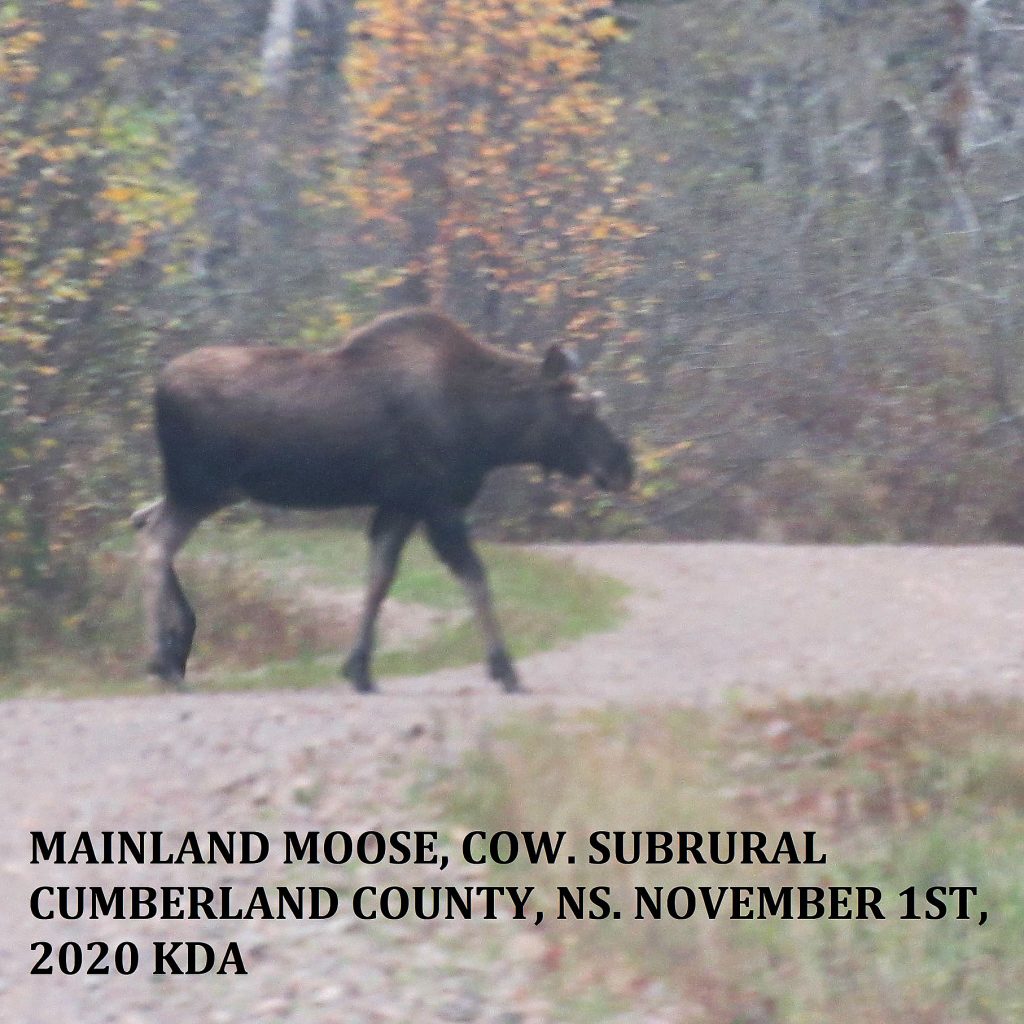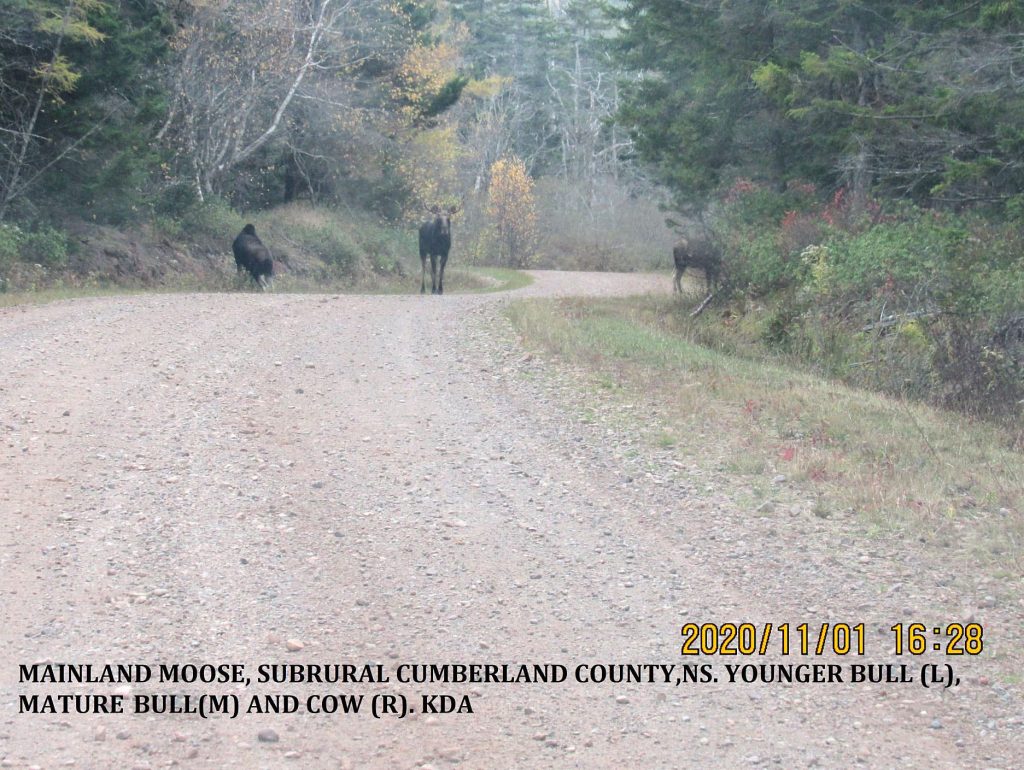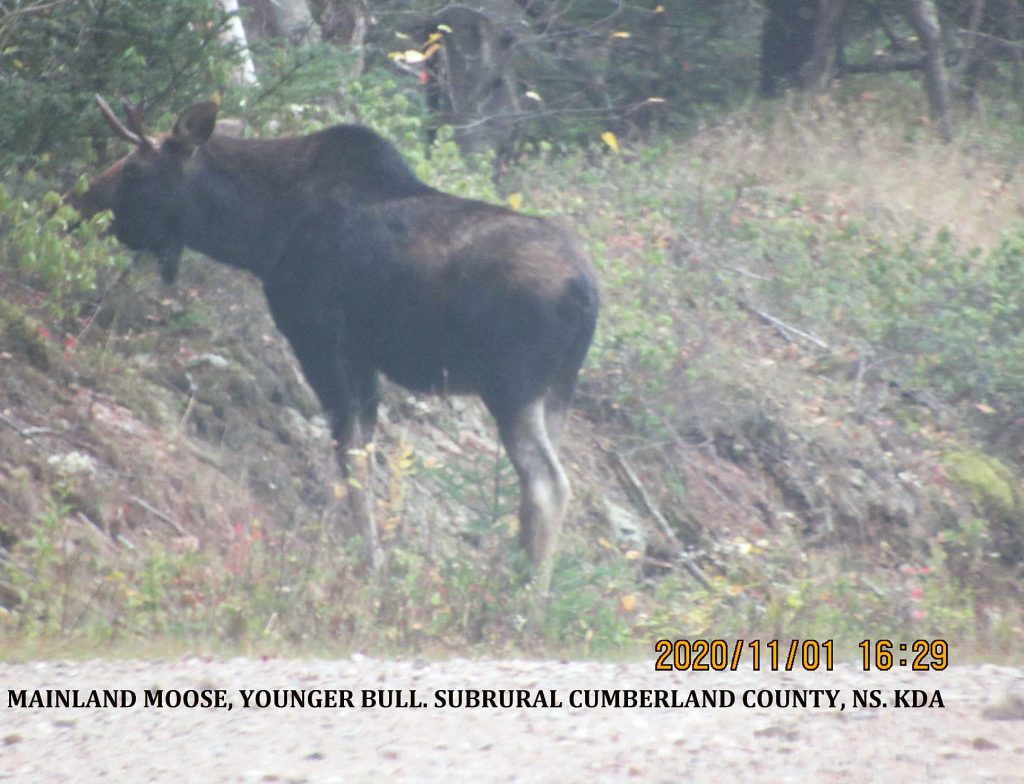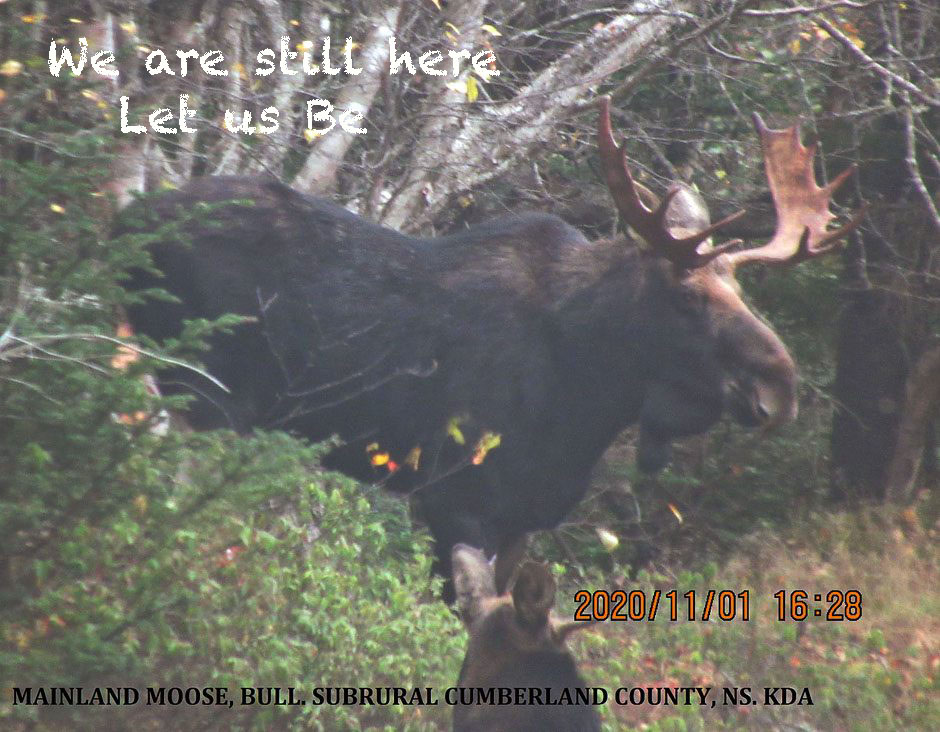Some pics of this magnificent animal in Cumberland Co. & a racap of its challenging recent history
We are hearing a lot about the Mainland Moose recently, but they are elusive and wary of humans and probably well less than 1% of Nova Scotians have seen them.
Ken Adams, recently retired as Director/Curator of the Fundy Geological Museum in Parrsboro, spends a lot of time observing rocks and wildlife in Cumberland Co.
He forwarded these wonderful pics of Mainland Moose taken on Nov 1., 2020. They seem to say in bold words: “We are still here. Let us Be”.
Thanks for sharing, KDA
LINKS – SOME HISTORY
1995
Moose Herd Perseveres
by: Mark Pulsifer in coNSservation
When Europeans first settled Nova Scotia’s coastline, moose were the largest member of the deer family. They shared the forests with one other deer species, the woodland caribou. White-tailed deer had been absent from this province for many years*, returning in the latter part of the 19th century. For a brief time, all three deer species co-existed. However, by the early 1920s caribou disappeared from our woodlands and barrens because of 300 years of market hunting, poaching, and habitat loss.
Similar population pressures have affected moose herds throughout Nova Scotia, resulting in dramatically fluctuating population levels. Some of these declines were so severe that the Provincial Game Commissioner’s Report of 1910 indicated that moose numbers had approached extinction twice since 1800. Even during the first half of the 20th century, moose numbers continued to fluctuate dramatically because of winter range conditions, herd size, and carrying capacity of the habitat.
Today’s moose herd size appears to be stable and even increasing in areas such as the Cape Breton Highlands and west of Kejimkujik National Park. Traditional population strongholds, such as the Cobequid Hills and the Pictou-Antigonish Highlands, have experienced significant declines in moose numbers. Prior to and during these declines (throughout the 1960s and 1970s), moose numbers were high enough to support an annual moose hunt. Declining hunter success prompted the closure of the mainland hunt after 1981.
*Deer were likely not present in NS &NB before settler times.
2003
The mainland (eastern) moose is listed as endangered under the Endangered Species Act.
2003
STATUS REPORT on The Eastern Moose (Alces alces americana Clinton) in Mainland Nova Scotia
by Gerry Parker
2004
Road Density and the Potential Impact on Wildlife Species such as American Moose in Mainland Nova Scotia
Karen F Beazley et al.,2004. In Proceedings of the Nova Scotian Institute of Science Vol. 42: 339-357
Road density alone and road density in combination with habitat suitability index values predict the presence of moose pellets, whereas habitat suitability values alone do not. Thus, road density may be an indicator of moose habitat selection or effectiveness in mainland Nova Scotia.
Biodiversity conservation activities in Nova Scotia and elsewhere could focus on
– discouraging further road densities above 0.6 km/km2;
– protecting remaining roadless and low road density areas;
– minimizing new road construction, especially in natural areas;
– decommissioning and regenerating old logging roads;
– increasing buffer zones between natural areas and roads; and providing road crossings for wildlife in the form of under and overpasses.
The distribution, status and habitat associations of moose in mainland Nova Scotia
TV Snaith and KF Beazley In Proceedings of the Nova Scotian Institute of Science Vol. 42 Part 2: 263-317
Throughout the Nova Scotia mainland, small and fragmented moose populations remain at varying densities and may be limited or regulated by a number of factors including interspecific competition, disease, habitat alteration/loss, mineral toxicity/deficiency, predation, poaching, and resource availability. Ranging behaviour and habitat requirements vary according to environmental factors; however, moose require food and cover in sufficient quantity and of appropriate interspersion to meet their daily and seasonal needs. Mature forest with a well developed understory, and open areas with early successional vegetation provide forage, while dense forest provides cover from thermal stress and deep snow. Strategies for moose conservation, such as through forest management, should concentrate on the preservation and enhancement of habitat to meet the critical requirements of viable moose populations and the re-establishment of connections among discrete populations.
2007
Mainland Moose Continue to be Poached
DNR Press Release
Recovery Plan for Moose (Alces alces americana) in Mainland Nova Scotia
Nova Scotia Endangered Species Act Recovery Plan Series, Nova Scotia Department of Natural Resources.
2012
Endangered Mainland Moose Special Management Practices
Nova Scotia Department of Natural Resources
2013
McNeil, Jeffie. 2013. Action Plan for the Recovery of Eastern Moose (Alces alces Americana) in Mainland Nova Scotia.
Mainland Moose Recovery Team and Mersey Tobeatic Research Institute, Kempt, Nova Scotia.
This Action Plan identifies 5 inter-related tasks to fill these knowledge gaps and begin to work towards recovery.
Task 1- Provide reliable data on the distribution, abundance and population structure of mainland moose in Nova Scotia
Task 2- Develop tools to support decisions in forest management planning at multiple spatial scales for moose habitat requirements
Task 3- Undertake studies on threats and limiting factors to enable an understanding of the causes of moose population decline
Task 4- Provide and implement management strategies leading to the recovery of the moose population
Task 5- Raise public awareness, build partnerships and encourage stewardship of mainland moose in NS
2015
Protected on Paper Only: Evaluation of Nova Scotia’s legal obligations to protect and recover mainland moose and other species-at-risk
Jamie Simpson, Steven Evans, & Lisa Mitchell, East Coast Environmental Law Association AND Environmental Law Students’ Society, Feb 2015
Nova Scotia’s mainland moose, listed as endangered in 2003, is an example of a species possibly threatened by the province’s shortcomings under the Act. In the mainland moose recovery plan, released 3 years later than legally mandated, DNR did not identify the core habitat necessary to sustain the remaining individuals, as is required under the Act. Nor did DNR attempt to chart a course in the plan to increase the number of moose to a sustainable level, also as required under the Act. Further, recovery plans are required to be evaluated every 5 years, and DNR has yet to evaluate the moose recovery plan since releasing it in 2007.
At the same time that DNR has failed to meet certain legal obligations to species at risk, it has moved forward with issuing new forest logging permits to forestry companies on lands that may overlap with habitat for some species at risk. In the absence of identified core habitat, the Endangered Species Act provides virtually no protection to species at risk from damaging forestry practices. ECELAW and ELSS are concerned that DNR’s resource extraction focus may be interfering with its responsibilities with respect to the province’s biodiversity and satisfying its legal obligations with respect to species at risk. Further, we note that Nova Scotia Environment (NSE) does not appear to be working with DNR to ensure species at risk are adequately conserved. As a result, NSE is not meeting its legal mandate to protect biodiversity, as it is required to do under the Environment Act.
We call on the province to take immediate action to comply with the Endangered Species Act. Identification of core habitat, and implementing actions already identified, is particularly important to the recovery of Nova Scotia’s species at risk. We also recommend that the Nova Scotia government move responsibility for species at risk from DNR to NSE, given NSE’s legislative mandate over the province’s biodiversity. A new path forward is necessary to give the public greater confidence that conservation laws are not undermined by DNR’s resource extraction mandate. Environment would be the logical department to be tasked with protecting biodiversity, given its mandate to do so under section 2 of the Environment Act.
2018
Species at Risk in Nova Scotia #2 :Mainland moose battle ticks, ATVs and clear cuts
CBC News “This is the second in a series of stories from CBC’s Information Morning about species that are struggling to survive in Nova Scotia, and the people who have vowed to save them.” Audio (Information Morning interview with Clifford Paul)
2019
N.S. naturalists taking province to court
By Alexander Quon Global News January 29, 2019
The Endangered Species Act is meant to “provide for the protection, designation, recovery and other relevant aspects of conservation of species at risk.”
The groups allege that Lands and Forestry Minister Iain Rankin has failed to meet those requirements for 34 endangered, threatened, and vulnerable species including the mainland moose, wood turtle, and bank swallow.
Bancroft, who was a forest biologist with the Department of Natural resources for 18 years, says that the province did not adequately respond to two reports that called for the government to better enforce the Endangered Species Act.
The first was a 2015 paper from the East Coast Environmental Law Association that found the government had not fulfilled its legal obligation under the Act.
The second was a 2016 report from the province’s Auditor General Michael Pickup that examined conservation management and recovery.
Pickup wrote that at-risk species needed to be a greater priority for the then-Department of Natural Resources, as they were not fully managing “conservation and recovery of species at risk.”
Bancroft says he and the organizations in the action aren’t undergoing the process lightly.
“Normally, naturalists are a quiet bunch that like to admire nature. In this particular case, they’ve seen too much,” he said.
From high overhead, a sobering look at a moose population in deep trouble
Phlis McGregor · CBC News May 24, 2019. “Aerial survey results obtained by CBC show a steep decline of the endangered mainland moose in Nova Scotia”
Top court rules province broke endangered species law
Francis Campbell on saltwire.com, May 29, 2019. “The case marked the first time the Endangered Species Act, enacted in the province in 1999, was interpreted by a Nova Scotia court…The judge agreed with the complainants’ arguments that the lands and forestry minister had failed to implement the Endangered Species Acts as it pertains to six representative species, namely the mainland moose, the ram’s-head lady slipper, the Canada warbler, the black ash, the wood turtle, and the eastern wood pewee. ”
Spot an endangered mainland moose? Here’s why you should report it
Alex Cooke · CBC News July 6, 2019. “There could be fewer than 100 mainland moose remaining in Nova Scotia”
2020

CBC Evening News on ‘The Blockade’ in Mainland Moose Habitat
It’s about 11 min in
Richard Amero shows the moose track by the side of a logging road on crown land near the Tobeatic Wilderness Area.”
CBC Information Morning Twitter, Oct 20
Protesters block logging road, say endangered moose at risk
Emma Smith, Phlis McGregor · CBC News Oct 28, 2020
BOB BANCROFT: Clearcuts squeeze out beleaguered mainland moose
Bob Bancroft in the Chronicle Herald, Nov 7, 2020 (image on WWNS) “Satellite images of clearcutting now spread like leprosy across the once-wooded body of Nova Scotia. The pace and scale of forest flattening on Crown land has set a horrible example for private lands, which also look like a measles rash from space.”
& no comment and no action by NS Lands & Forestry…
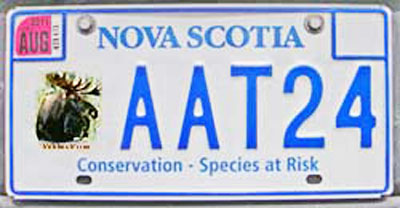
Why Not? Florida did it for the Florida Panther. We did it for the Piping Plover.
——–
I spent a lot of time on the lookout for a Mainland Moose while I was an active member of the Woodens River Watershed Environmental Organization 2009-2018 and explored much of the Chebucto Peninsula where a group of 25-30 moose resided. I frequently saw footprints and scat; amongst the places was forested land by the Woodens River that belongs to my family. People who lived in the Hubley area and down the Peggy’s Cove Road on the east side of St. Margaret’s Bay often viewed them, and there were reports of moose crossing Highway 103 until about 2-3 years ago when sightings became rare.
The closest I ever came to a moose on the Chebucto Peninusla was about 10 meters – but it was in complete darkness and I didn’t actually see it!
In early September of 2011 I had hiked with my son-in-law Vasile to a drumlin deep in the Chebucto Peninsula to check out, for the second time, a multi-aged old growth red oak stand. There was lots of moose scat there as there had been the first time I visited it, in 2009.
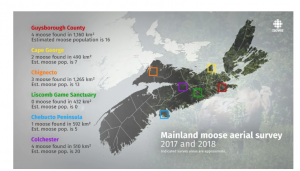
From CBC: From high overhead, a sobering look at a moose population in deep trouble. Phlis McGregor, May 24, 2019 Chebucto Moose: 5
It was warm and the weather forecast was good so we had not brought tents, and would just sleep on groundsheets. We forgot to bring a flashlight. I was sound asleep and was woken up by the sounds of Vasile banging a piece of a fallen limb on a tree trunk. “What’s going on”? I asked. “A big animal was approaching us”, he said…eventually we went back to sleep. I woke up again to the bangs on the tree… and heard a grunting and snorting sound coming closer and closer… all in complete darkness. We were quiet and eventually it went away and we slept soundly for the rest of the night.
I was pretty sure it had been a bull moose. When I got home I did a google search for bull moose calls and the sound was a perfect match. Later when I recounted the story to someone who knows wildlife well, he said banging on the trees was probably the worst thing we could do. It was mating season and the bull moose likely thought the noise was the action of another bull moose infringing on his territory and he was coming to confront it.
So I was perhaps 10 meters from this magnificent animal so well captured in the photo by Ken Adams, and couldn’t even see it.
We were lucky it left us alone. The Chebucto moose haven’t been so lucky. DNR/L&F gave up on them 10+ years ago. A moose wintering yard by the lower Woodens River was clearcut a couple of years ago, and now the group is down to, reportedly, 5 moose.


